A fruity farewell to our summer

The word "ambivalent" doesn't really exist in my vocabulary, but there is no other word to describe my feelings for the last month of summer.
On the one hand, it's objectively flawless: long, lazy days of abundant sunshine, spontaneous trips to the beach, endless streams of extremely cold wine and a constant parade of flawless produce.
On the other hand, it is simply the worst: now we are all back at school and work we are reminded of all of the things we wanted to do this summer that have not quite happened.
Fortunately, I have developed coping mechanisms for countering this anxiety, and at the top of that list is buying summer fruit. All of the summer fruit. Possibly too much of the summer fruit.
Watching me at a farmers' market is like watching a contestant on Supermarket Sweep, a wild woman whirling through the stands, fuelled by her fear of impending scarcity. I can't know peace until I have grabbed every last basket of berries, filled several paper bags with peaches, nectarines, apricots and plums, and plopped more melons than one person should reasonably be allowed to carry into totes. I do not have to tell you that the fruit is an obvious metaphor for the last days of summer I am desperately trying to hoard and enjoy.
This is great, because fresh fruit, in its most pure and unadulterated state, is one of the few things in life that is perfect as is. It also presents a problem, because one person just can't eat that much fresh fruit before it bruises, moulds or goes bad.
So what to do with the excess? Sure, you could freeze some of it, but there's no fun in that. It's too hot to make jam (I said it!), so that's out. But what's in are desserts that allow you to use a ton of fruit at once, require almost no time or skill to prep, bake in under 45 minutes (yes, I'd argue that turning the oven on produces less heat in the kitchen than making jam), or better yet, don't bake at all.
While it may seem counterintuitive, I spend more time indoors making desserts during late summer than any other time of year. Honestly, I can't think of a better way to spend my time.
Here you'll find five unfussy, rather foolproof desserts, the kind you can almost pull together with your eyes closed, meant to be made successfully by people with any level of baking prowess (or no baking prowess at all). These are recipes in which fruit is allowed to be the centre of attention, using only as much sugar as needed to help each fruit be the best version of itself.
There's a buttery salted cobbler made with apricots (or any stonefruit you like) and a healthy drizzle of honey, made for eating with obscene amounts of vanilla ice-cream; a crumbly, jammy tart made with blueberries and polenta, ideal for slicing into wedges and taking with you to the nearest body of swimmable water; a cake studded with strawberries that tastes like an old-fashioned doughnut; refreshingly tart, frozen, icy melon (finished with salt, because eating melon with salt is one of the tenets of summer); and a British summer pudding, a beautiful mess of a dessert that looks and eats like a giant, berry-stained tiramisu.
While each recipe is designed to get the most out of its designated fruit, there is some flexibility based on what's available at the farmers' market or looking too good to pass up. Feel free to consider the fruit in each recipe as a suggestion or starting point.
These dead-simple desserts make great picnic snacks, beach treats and bring-a-plate additions. They are also the ideal antidote to end-of-summer sadness, to be enjoyed alone in your kitchen at 10.30pm while you reflect on all the summer holidays you'll almost certainly take next year.
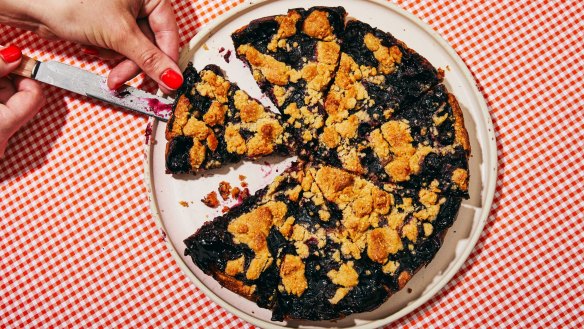
Blueberry polenta shortbread tart
INGREDIENTS
For the crust and topping
190g (1½ cups) plain flour
55g (⅓ cup) polenta
50g (⅓ cup) icing sugar
55g (¼ cup) light brown sugar
1 tsp baking powder
¾ tsp table salt
¾ cup (170g) unsalted butter, melted and cooled slightly
For the filling
450g blueberries
110g (½ cup) light brown sugar
1½ tbsp apple cider vinegar or fresh lemon juice
1½ tbsp plain flour
small pinch of sea salt
METHOD
1. Heat oven to 175C.
2. To make the crust and topping, whisk together flour, polenta, icing sugar, brown sugar, baking powder and salt in a medium bowl. Add melted butter, then use your hands or a wooden spoon to combine ingredients until no dry spots remain.
3. Press half of the polenta mixture into a 22cm tart tin with a removable bottom (alternatively, use a 22cm cake tin or springform tin, lined with baking paper), making sure the mixture is evenly pressed on the bottom and about 1cm up the sides. (Using something large and flat, like the bottom of a measuring cup, will be helpful.) Reserve the remaining mixture.
4. To make the filling, toss blueberries, brown sugar, vinegar, flour and salt together in a medium bowl. Pour the fruit into the crust.
5. Crumble the remaining polenta mixture over the blueberries, pressing bits of the mixture together into large clumps as you go.
6. Bake tart until the blueberry filling is bubbly and thickened, and both the crust and top are nicely browned, 40 to 45 minutes.
7. Let tart cool completely before slicing into triangles and serving. The tart can be baked up to two days ahead and stored tightly wrapped at room temperature or refrigerated (especially if your kitchen is hot or humid).
Serves 8-10
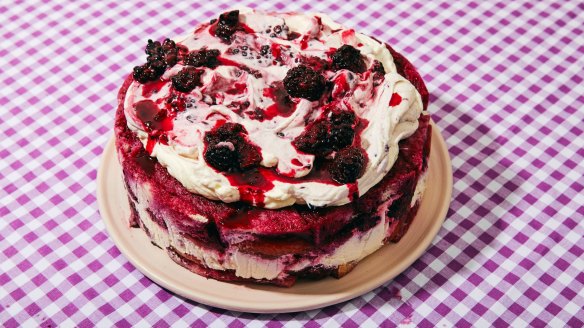
Summer pudding with blackberries and peaches
INGREDIENTS
900g peaches or nectarines (about 5), pitted and sliced 2.5cm thick
140g (⅔ cup) sugar, plus more for serving
3 tsp finely grated ginger (optional)
680g blackberries or raspberries, plus an extra handful for garnish
2 cups (480ml) cream
35g (¼ cup) icing sugar
240g (1 cup) labne, mascarpone or full-fat Greek yoghurt
1 loaf brioche (about 570g), crusts removed, bread sliced 1cm thick
pinch of sea salt
METHOD
1. Combine peaches, ⅓ cup sugar and the ginger, if using, in a medium saucepan over medium heat. Bring to a simmer and cook, swirling occasionally, until the peaches have started to release their juices (but are not falling apart into mush), 8 to 10 minutes. Remove from heat and transfer to a medium bowl; set aside to cool completely.
2. Without rinsing out the saucepan (there's no need), combine the berries and remaining ⅓ cup sugar. Bring to a simmer and cook, swirling occasionally, until the berries have started to release their juices (but are not falling apart into mush), 8 to 10 minutes. Remove from heat and transfer to a medium bowl, separate from the peaches; set aside to cool completely.
3. Meanwhile, using an electric mixer or a whisk, beat cream and icing sugar until spreadable, pillowy, medium peaks form, 3 to 4 minutes. Whisk in labne until well blended.
4. Line a springform cake tin with plastic wrap so that there is ample overhang. (A regular cake pan will also work; just make sure it has high sides or you might need to make the pudding in two vessels.)
5. Place one layer of sliced bread on the bottom. Cut the bread to fit as needed to make sure there is an even layer with no obvious gaps (aesthetics don't matter here, as it'll be covered up).
6. Spoon one third of the berry juices onto the bread to thoroughly soak, followed by half of the berries themselves. Spoon one third of the peach juices onto the bread and berries, followed by half of the peaches themselves.
7. Spread one third of the cream mixture onto the fruit and top with another layer of bread, making sure to fill any obvious gaps with bread that's cut to fit. Top bread with another one third of the berry juices and all of the remaining berries, followed by one third of the peach juices and all of the remaining peaches. Top with one third of the cream mixture, setting the remaining cream mixture aside in the fridge.
8. Place another layer of bread on top, making sure to fill any obvious gaps, especially around the edges, with bread that's cut to fit. Spoon remaining third of the blackberry and peach juices on top, making sure to stain the entire surface. Place a piece of plastic wrap on top and then place a plate on top of the plastic. Rest a heavy tin (or another medium-sized, relatively heavy, food-safe object) on top to lightly compress the whole shebang. Refrigerate for at least 4 hours.
9. When you're ready to serve, crush a handful of berries with a sprinkling of sugar; let sit for a few minutes. Remove springform sides and plastic wrap. (If using a regular cake pan, lift the pudding out by the excess plastic and transfer the entire pudding to a plate, platter or cake stand, removing plastic wrap.)
10. Take the remaining cream mixture and top the pudding, swirling in the crushed berries to create streaks and swirls. Slice (or spoon) the pudding and serve. Pudding can be assembled three days ahead, stored tightly wrapped and refrigerated.
Serves 8-12
Salted apricot-honey cobbler
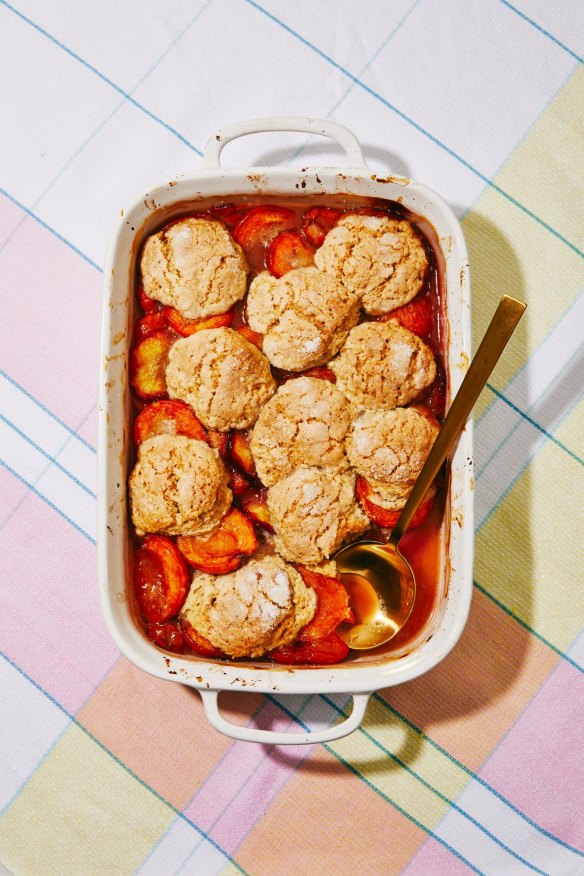
For the shortcake topping
175g (1⅓ cups) plain flour
55g (½ cup) quick-cooking oats
50g (¼ cup) sugar, plus more for sprinkling
3 tsp baking powder
¾ tsp table salt
115g (½ cup) unsalted butter, cut into 2½-cm pieces, chilled
120ml (½ cup) cream, plus more for brushing shortcakes
sea salt flakes, for sprinkling
For the filling
900g apricots, pitted and halved (or quartered if very large)
60ml (¼ cup) honey
3 tsp cornflour
1½ tbsp fresh lime or lemon juice
pinch of table salt
METHOD
1. Heat oven to 175C.
2. To make the shortcake topping: Combine flour, oats, sugar, baking powder and salt in a large bowl. Using your hands, rub the butter into the flour mixture until there are no large chunks left. Add ½ cup cream and mix just until blended, then turn the dough out onto lightly floured work surface.
3. Knead dough just until it's no longer super-sticky, and then pat the dough out so it's 2½-cm thick. (The shape here doesn't matter; you'll be cutting out circles.) Using a 5cm-round cutter, or something about that size (water glasses and jars also work), punch out as many shortcakes as you can. Gently gather and re-pat the scraps so they're 2½-cm thick and repeat until all the dough is used. You should have eight or nine shortcakes.
4. To prepare the filling: Toss apricots with honey, cornflour, lime juice and salt in a 2-litre baking dish (a 20cm-by-28cm or 23cm-by-33cm dish will work), then flip the fruit so they are all cut-side up. The apricot pieces will overlap a bit, and this is fine. Top with shortcakes; they will puff and spread quite a bit, so leave them well spaced. The idea is to have lots of fruit exposed once baked, so don't worry about the shortcakes covering every square centimetre. Brush the shortcakes with cream, and sprinkle with a little bit of sugar and sea salt flakes.
5. Bake until shortcakes are golden brown and the juices of the apricot have thickened and bubbled up around the edges of the baking dish, 40 to 45 minutes.
6. Remove from oven and let cool slightly before eating (though it's even better at room temperature). This cobbler is the best the day it's made, but it can be baked a day ahead and stored tightly wrapped at room temperature.
Serves 6-8
Old-fashioned strawberry cake
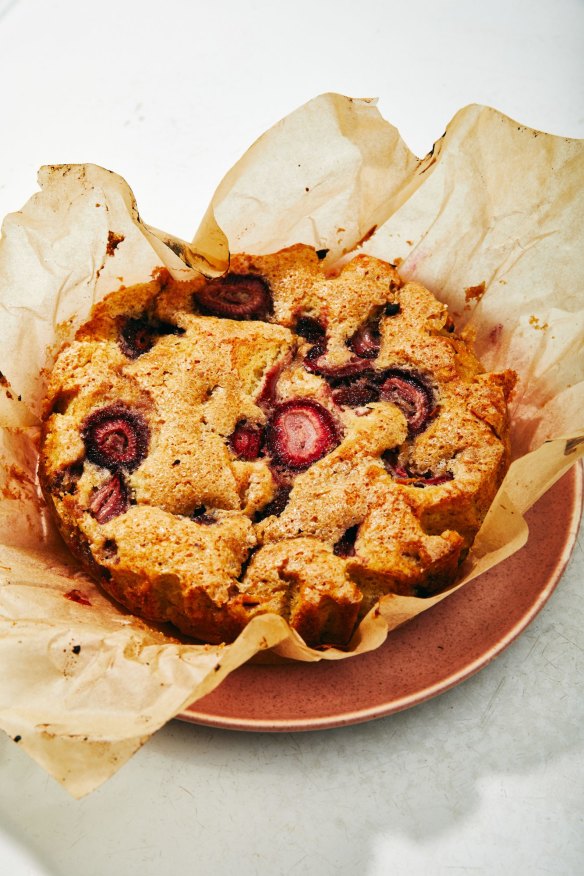
INGREDIENTS
115g (½ cup) unsalted butter, softened, plus more for tin
255g (2 cups) plain flour
2 tsp baking powder
¾ tsp table salt
70g (⅓ cup) sugar
75g (⅓ cup) light brown sugar
1 tsp vanilla extract
2 large eggs
180ml (¾ cup) buttermilk
190g strawberries, hulled and sliced ½-cm thick
2 tbsp plus 1 tsp demerara sugar, for sprinkling (you can use sugar in a pinch)
METHOD
1. Heat oven to 175C. Smear or brush a bit of butter onto the bottom of a 23cm cake tin and line with baking paper (either cut to fit the bottom, or leaving some hanging over the edges for easy removal).
2. Whisk flour, baking powder and salt together in a medium bowl.
3. In a stand mixer (or using an electric hand mixer and a large bowl), beat butter, sugar, brown sugar and vanilla together on medium-high, periodically scraping down the sides of the bowl to make sure everything incorporates, until the mixture is pale, light, fluffy and creamy, about 5 minutes.
4. Add eggs, one at a time, beating to blend between additions. (This is a good time to scrape down the sides again.)
5. Reduce the mixer speed to low and carefully add half the flour mixture, followed by half the buttermilk. Repeat with remaining flour mixture and buttermilk, beating just until no large lumps remain.
6. Using a spatula, gently fold in half the strawberries and transfer the batter to the prepared cake tin. Scatter with remaining strawberries and sprinkle with demerara sugar.
7. Bake until cake is puffed, deeply golden brown on the top and pulling away at the sides, 45 to 50 minutes. (It should spring back slightly when pressed in the centre and appear fully baked where the strawberries meet the cake.)
8. Let cake cool completely before removing it from the tin (either by inverting or lifting with the baking paper lining). The cake can be baked up to three days ahead and stored tightly wrapped at room temperature, or refrigerated.
Serves 8-10
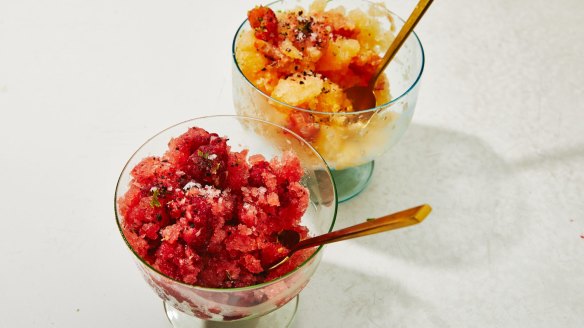
Frozen melon with crushed raspberries and lime
INGREDIENTS
640g (4 cups) cut melon, such as cantelope, watermelon or a mixture (remove the rind of a whole melon and cut into 5cm chunks to get 4 cups)
125ml (½ cup) fresh lime juice, plus more as needed
1½ tbsp sugar, plus more as needed
90g raspberries
3 tsp finely grated lime zest
sumac (optional)
sea salt flakes (optional)
METHOD
1. Blend melon in a food processor or blender until completely smooth; you should have about 4 cups puree. Transfer to a 23cm-by-10cm loaf tin (or a shallow baking dish, if you have space for it in your freezer).
2. Add ½ cup lime juice and 1½ tablespoons sugar and stir to blend; season with more lime juice and sugar, as needed. The mixture should be fairly tart and sweet. (The sweetness dulls once the mixture is frozen, so stay on the sweeter side now.) Place in freezer and let freeze until completely solid, anywhere from 2 to 4 hours, depending on your freezer.
3. Once the mixture is frozen, use a spoon or fork to scrape the frozen melon into a fluffy pile of ice. If it becomes soft or melty when scraping, place it in the freezer until it's solid enough to scrape again.
4. If serving immediately, lightly pack some of the ice into serving glasses or bowls. (If not, transfer the ice to a resealable container and freeze until ready to serve. The frozen melon can be prepared up to two weeks ahead; if scraped, it might need a little re-fluffing before serving.) Top each serving with raspberries and use a spoon or fork to crush them into the ice. Top with more ice, followed by a bit of lime zest, and then a little sumac and salt flakes, if using.
Serves 6
Food stylist: Alison Roman; photos: Michael Graydon and Nikole Herriott
©The New York Times
Appears in these collections
More:
From our partners
Original URL: https://www.brisbanetimes.com.au/goodfood/what-to-do-with-all-that-summer-fruit-20200128-h1ldsp.html
